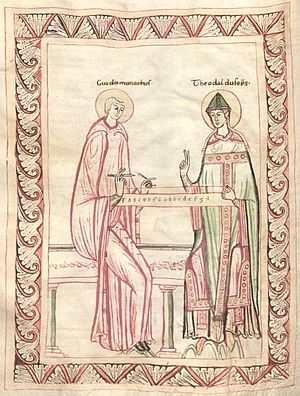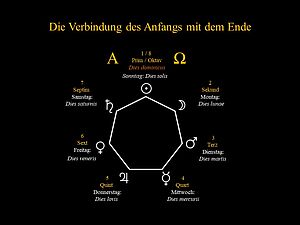B11 What you might not want to tell ...
What mathematically or physically assumes no size, is usually numbered zero. An interval with the distance zero, however, is called Prim, because the zero came quite late - after 1200 - from the Arab world to Europe.
Since then, musicians compare a single tone with itself and identify matches. They call this phenomenon consonance.
Test: Take a photograph of a chair 2 times from the same place and then compare the photos. Amazing: The backrest looks the same and the right leg has been damaged in exactly the same place. Conclusion: Whenever you compare something with itself, you will find something identical.
Now count to 8. In mathematics you are dealing with sizes and distances, in music with whole-tone and semitone steps. Five whole-tone steps and two semitone steps lead to the octave. In mathematics, you would need five wholes and six halves to arrive at the eight. That doesn't matter at the moment, because you will discover the reason.
The tone you hit on reaching the octave has the same letter name as the one you started with, because they are so akin to each other. The homonym is supposed to express similarity, as if they had no distance from each other and were in fact merged. It's like closing a circle by combining the beginning with the end.
Mathematically, the frequency of the first note has been doubled. Two is twice the one. That twice of the same thing is similar to each other, I do not have to explain again. And the similarity can not only be calculated, you can hear it - and you would taste it, if you eat 2x the same or twice as much. Are we again talking about consonance? Musicians do so and the listeners are delighted.
Now a theologian joins in and finds all this very amazing. The 1 (Prim, which is actually a zero) reminds him of the beginning of all things, the 8, (which would have to be a six) to the 8 blessings of the Sermon on the Mount (which, in turn, would have to be nine because the disciples were not count as if they did not deserve salvation, compare Matthew 5: 3-12). And everything is so perfect matching with the A and Ω - yes, certainly: just only not the counting method.
But maybe everything was the other way around: A theologian wanted to establish the connection with the Holy Scriptures and changed the natural sound series according to his worldview. In this way, the monk Guido of Arezzo (*992-†1050), but also some monks before him, could gain prestige with his superiors. It just always had to look like former generations would wanted to say the same before. This gives honor and meaning to the whole. Thanks to this mental chain reaction - the continuity of piety - we have a sound system tailor-made for theological needs. Every historical layer has its own references.
Guido of Arezzo and Bishop Theodaldo are discussing a monochord, Österreichische Nationalbibliothek, Musiksammlung, Vienna, Codex Lat. 51, fo35v, 12th century
Now listen carefully: there is usable scholarship and useless scholarship. Even fake news are often taken up when they are strategically useful. The Donation of Constantine was e.g. very helpful for the church, although it was a forgery. The value of the truth is not appreciated if it can not be used to any advantage. There are also many uncomfortable truths. Nobody likes them. Anyone who strives for truth alone and thinks too little of himself, starts a journey of suffering.
The theologians were concerned with something important. They saw the parable in music, the model of thought, the didactic aid. They heard the consonance as much as they saw the light. They envisioned that a higher power - the creator of all things - exists beyond our sense perception - that it begins just past our most beautiful impressions - behind the light and the consonance - hoping that sometimes a little divinity would shimmer through - like the light through a church window. Theologians are not praying to the sun. Anyone who wants to describe something that cant' be shown directly has to resort to analogies (parables). Therefore, our cultural history is so filled with religious symbolism that sometimes you can not see the sky because of the amount of angels.
Let's take, for example, the weekdays. Earlier we started counting with Sunday, the day of the Lord (dies dominica). This is the only way to understand what Guido von Arezzo writes: "For as we begin again from the beginning after seven days, so we always designate the first and the eighth day as the same, and we designate and name the first and the eighth sound always with the same letter, because we feel that they are in natural harmony in tone, such as D and d." The connections within the Christian worldview can hardly better be described.
This has nothing to do with a scientific consideration, or rather: acoustic exploration of natural sounds. The Guidonic division doesn't represent a tuning system but a theological dream, in which it is possible to count up to eight on existing seven days of the week and to reduce the number of eight selected tones to seven by double-naming. Only this way it is possible to relate both with each other. Although Guido von Arezzo refers to Pythagoras, he has created something new, which owes nothing to the Greek prehistory. Therefore one speaks of ecclesiastical modes.
On this page, the ethical content of the Western harmonical system is first time recognized as such and appreciated. Ethics is not about favoring a belief but simply about functioning living together. Therefore, we speak of harmony among sounds and harmony among people. This harmony is not self-evident - it is more of a rarity. Many people, but especially those who suffer as a result of injustice long for it - no matter which culture they belong to.
Well, now you comprehend the meaning and don't have to wonder about an illogical sound system.
Musicology still believes that our sound system derives from the Greeks. However, they were able to count very well.




